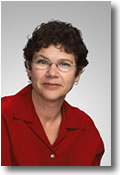'Cyberinfrastructure and the Social Sciences' Report Released
A comprehensive final report has been released from the National Science Foundation’s workshop on “Cyberinfrastructure and the Social Sciences” held in March 2005. The workshop brought together a gathering of social science and computer science leaders and thinkers to discuss in depth how the disciplines can work together to develop, deploy and use cyberinfrastructure – the coordinated hardware, software and human resources and information technologies required to enable modern science, engineering and societal applications integrated through the Internet and modern telecommunications.
|
"This SBE-CISE workshop broke new ground by enabling these communities to explore key issues and opportunities for collaboration in designing, developing and delivering better information infrastructure," said Arden Bement, Director of NSF. "The final report leverages the immense expertise of NSF communities to develop useful and usable Cyberinfrastructure to support breakthrough science and engineering research and education for the 21st century.”
“The final report lays out an ambitious agenda for how cyberinfrastructure can help the social sciences and how the social sciences can help advance cyberinfrastructure,” said Henry Brady, Professor of Political Science and Public Policy at U.C. Berkeley, Director of UC Data and co-author of the report. “By working together, computer scientists and social scientists can help cyberinfrastructure achieve its full potential as an enabler of new discovery.”
The report states that the expansion of cyberinfrastructure can make it possible for the social and behavioral sciences “to make a giant step forward” and focuses on some of the most pressing problems that teams of social and computer scientists are well-positioned to attack. These include the development of secure infrastructure that minimizes the amount and damage of malevolent and “hacker” behavior, the allocation of shared public information and computational resources such as the Internet to deal effectively with “peak” or “urgent” demand (as in emergencies) and the testing of new policy proposals such as energy markets through Web-based simulations to uncover problems before they lead to large-scale policy failures.
“The Workshop catalyzed a new community capable of developing safe, user-friendly, and useful information infrastructure,” said Fran Berman , Professor of Computer Science and Engineering at U.C. San Diego, Director of the San Diego Supercomputer Center and co-author of the report. “The report contains a core set of ideas for evolving cyberinfrastructure and for achieving the immense potential of information technology.”
The workshop represented a broad set of perspectives. These perspectives were furthered by the plenary speakers: Dr. Bement, Dr. Dan Atkins, Chair of the Blue Ribbon Advisory Panel on Cyberinfrastructure, and Dr. Nikolaos Kastrinos, of the European Commission. Both the CISE (computer science) and SBE (social science) directorates at NSF provided encouragement and support and participated in the workshop along with community leaders.
"I believe that this workshop has been very important in bringing together the social/behavioral sciences and computer science research and education communities to seize the opportunities and tackle the challenges posed by cyberinfrastructure,” said Wanda Ward, Acting Assistant Director from the Social, Behavioral, and Economic Sciences Directorate. “We have not yet tapped the enormous potential for collaboration between these research communities to frame, build, understand, and use cyberinfrastructure effectively, and the March workshop has provided a plan and a way forward to promote that collaboration. I also anticipate a significant expansion in the fundamental knowledge base of the social and behavioral sciences resulting from the full deployment of a shared cyberinfrastructure."
"This workshop also explored the economic impact of cyberinfrastructure and the exciting possibilities for rapid technology transfer, thereby leveraging the nation's investment in S&E research," said Sangtae Kim, Division Director of CISE/SCI. "The background knowledge and experiences of the workshop participants were especially appropriate for this timely topic.”
The workshop was organized by a team of computer and social scientists – computer science Professor Ruzena Bajcsy, computer science Professor and San Diego Supercomputer Center Director Fran Berman , political science Professor and UC Data Director Henry Brady, and economics Professor John Haltiwanger. Both the Workshop and its resulting report present a true melting pot of multi-disciplinary ideas. The report is available on the web at http://vis.sdsc.edu/sbe/.
About SDSC
In 2005, the San Diego Supercomputer Center (SDSC) celebrates two decades of enabling international science and engineering discoveries through advances in computational science and high performance computing. Continuing this legacy into the era of cyberinfrastructure, SDSC is a strategic resource to science, industry, and academia, offering leadership in data management, grid computing, bioinformatics, geoinformatics, high-performance computing, and other science and engineering disciplines. SDSC is an organized research unit of the University of California , San Diego with a staff of more than 400 scientists, software developers and support personnel, primarily funded by the National Science Foundation (NSF). For more information, see www.sdsc.edu.
Media Contacts
Greg Lund, SDSC Communications, 858-534-8314 or greg@sdsc.edu
Ashley Wood, SDSC Communications, 858-534-8363 or awood@sdsc.edu

